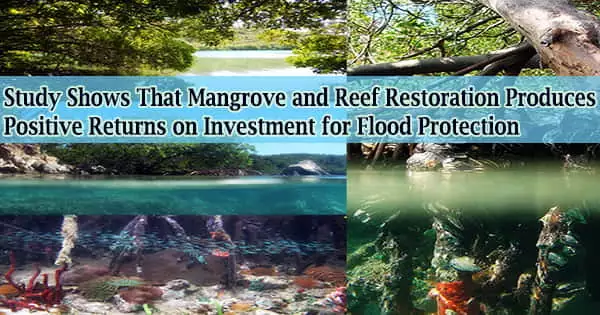According to a recent analysis, restoring mangroves and coral reefs can reduce coastal flooding in more than 20 Caribbean nations for a reasonable price.
The study, which was released on May 28, 2022, in the journal Ecosystem Services, used techniques from the risk and insurance industries to rigorously evaluate these natural defenses and demonstrate that they can provide a positive return on investment, with the advantages from decreased flood damage outweighing the costs of restoration.
The findings suggest new possibilities for financing restoration operations with money from sources that assist hazard mitigation, climate adaption, and catastrophe recovery, such as the U.S. Federal Emergency Management Agency (FEMA).
“We identify a number of funding sources that have traditionally supported artificial ‘gray infrastructure,’ such as concrete sea walls, and that could be applied to nature-based solutions,” said lead author Michael Beck, a research professor in the Institute of Marine Sciences at UC Santa Cruz who holds the AXA Chair in Coastal Resilience.
Coral reefs and mangroves are examples of coastal ecosystems that operate as natural barriers to waves and storm surges, minimizing flood damages to people and property. However, in many locations, the natural ability of reefs and coastal wetlands to protect coastlines from flooding and erosion has been diminished.
Effective restoration methods exist, but finance for restoration projects can be challenging to come by. Beck pointed out that compared to expenditure on conservation, disaster recovery costs are more than 100 times higher globally.
We identify a number of funding sources that have traditionally supported artificial ‘gray infrastructure,’ such as concrete sea walls, and that could be applied to nature-based solutions.
Michael Beck
“Recovery funding will grow as climate change increases the impacts from storms, and environmental funding will likely shrink as national budgets are strained by natural disasters,” he said.
The study identifies ways to coordinate environmental protection, flood risk mitigation, and climate adaptation to lower storm risks.
“Funding for artificial infrastructure such as seawalls can be redirected to natural defenses, which provide multiple benefits beyond coastal protection,” Beck said.
According to him, changes in discount rates and the timing of flood protection advantages have no effect on the study’s outcomes for return on investment.
“This may sound esoteric, but it can be critical to getting funding for restoration projects from sources such as FEMA,” he said.
The researchers pinpointed specific locations where Caribbean coral reef and mangrove restoration could yield sizeable returns on investment.
In addition to Beck, the coauthors of the paper include Nadine Heck, Siddharth Narayan, Pelayo Menéndez, Borja G. Reguero, and Stephan Bitterwolf at UC Santa Cruz; Saul Torres-Ortega and Iñigo J. Losada at the University of Cantabria, Spain; Glenn-Marie Lange at the World Bank; Kerstin Pfliegner at ERM, Germany; and Valerie Pietsch McNulty at the Nature Conservancy.
The Kingfisher Foundation, the World Bank, AXA XL, AXA Research Fund, the Nature Conservancy, and Germany’s Federal Ministry for the Environment, Nature Conservation, and Nuclear Safety all contributed to the funding of this project.





